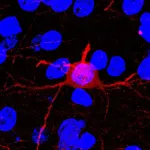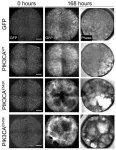(Press-News.org) Excess weight or obesity boosts risk of death by anywhere from 22% to 91%—significantly more than previously believed—while the mortality risk of being slightly underweight has likely been overestimated, according to new CU Boulder research.
The findings, published Feb. 9 in the journal Population Studies, counter prevailing wisdom that excess weight boosts mortality risk only in extreme cases.
The statistical analysis of nearly 18,000 people also shines a light on the pitfalls of using body mass index (BMI) to study health outcomes, providing evidence that the go-to metric can potentially bias findings. After accounting for those biases, it estimates that about 1 in 6 U.S. deaths are related to excess weight or obesity.
“Existing studies have likely underestimated the mortality consequences of living in a country where cheap, unhealthy food has grown increasingly accessible, and sedentary lifestyles have become the norm,” said author Ryan Masters, associate professor of sociology at CU Boulder.
“This study and others are beginning to expose the true toll of this public health crisis.”
Challenging the obesity paradox
While numerous studies show that heart disease, high blood pressure and diabetes (which are often associated with being overweight) elevate mortality risk, very few have shown that groups with higher BMIs have higher mortality rates.
Instead, in what some call the “obesity paradox,” most studies show a U-shaped curve: Those in the “overweight” category (BMI 25–30) surprisingly have the lowest mortality risk. Those in the “obese” category (30–35) have little or no increased risk over the so-called “healthy” category (18.5–25). And both the “underweight” (less than 18.5) and extremely obese (35 and higher) are at increased risk of death.
“The conventional wisdom is that elevated BMI generally does not raise mortality risk until you get to very high levels, and that there are actually some survival benefits to being overweight,” said Masters, a social demographer who has spent his career studying mortality trends. “I have been suspicious of these claims.”
He noted that BMI, which doctors and scientists often use as a health measure, is based on weight and height only and doesn’t account for differences in body composition or how long a person has been overweight.
“It’s a reflection of stature at a point in time. That’s it,” said Masters, noting that Tom Cruise (at 5 feet 7 inches and an extremely muscular 201 pounds at one point), had a BMI of 31.5, famously putting him in the category of “obese.” “It isn’t fully capturing all of the nuances and different sizes and shapes the body comes in.”
To see what happened when those nuances were considered, Masters mined the National Health and Nutrition Examination Survey (NHANES) from 1988 to 2015, looking at data from 17,784 people, including 4,468 deaths.
He discovered that a full 20% of the sample characterized as “healthy” weight had been in the overweight or obese category in the decade prior. When set apart, this group had a substantially worse health profile than those in the category whose weight had been stable.
Masters pointed out that a lifetime carrying excess weight can lead to illnesses that, paradoxically, lead to rapid weight loss. If BMI data is captured during this time, it can skew study results.
“I would argue that we have been artificially inflating the mortality risk in the low-BMI category by including those who had been high BMI and had just lost weight recently,” he said.
Meanwhile, 37% of those characterized as overweight and 60% of those with obese BMI had been at lower BMIs in the decade prior. Notably, those who had only recently gained weight had better health profiles.
“The health and mortality consequences of high BMI are not like a light switch,” said Masters. “There’s an expanding body of work suggesting that the consequences are duration-dependent.”
By including people who had spent most of their life at low-BMI weight in the high-BMI categories, previous studies have inadvertently made high BMI look less risky than it is, he said.
When he looked at differences in fat distribution within BMI categories, he also found that variations made a huge difference in reported health outcomes.
Exposing a public health problem
Collectively, the findings confirm that studies have been “significantly affected” by BMI-related bias.
When re-crunching the numbers without these biases, he found not a U-shape but a straight upward line, with those with low BMI (18.5–22.5) having the lowest mortality risk.
Contrary to previous research, the study found no significant mortality risk increases for the “underweight” category.
While previous research estimated 2 to 3% of U.S. adult deaths were due to high BMI, his study pegs the toll at eight times that.
Masters said he hopes the research will alert scientists to be “extremely cautious” when making conclusions based on BMI. But he also hopes the work will draw attention to what he sees not as a problem for individuals alone to solve but rather a public health crisis fueled by an unhealthy or “obesogenic” environment in the U.S.
“For groups born in the 1970s or 1980s who have lived their whole lives in this obesogenic environment, the prospects of healthy aging into older adulthood does not look good right now,” he said. “I hope this work can influence higher-level discussions about what we as a society can do about it.”
END
Excess weight, obesity more deadly than previously believed
One in six U.S. adult deaths are related to country's 'obesogenic' environment, study suggests
2023-02-25
ELSE PRESS RELEASES FROM THIS DATE:
Clues about the northeast’s past and future climate from plant fossils
2023-02-25
Ancient climates can help us understand the past, but also the future. 23 million years ago, in a time called the Miocene Epoch, Connecticut was around five to six degrees warmer than today and located roughly where Long Island is now. By the end of the Miocene, around five million years ago the earth had gradually cooled, Antarctica was glaciated, and there was some Arctic ice as well.
This cooling scenario moved in the opposite direction of today’s changing climate. One difference UConn Department of Earth Sciences Assistant Professor in Residence Tammo Reichgelt points out is that in the past, these changes happened gradually, spaced ...
A new epigenetic brain defense against recurrence of opioid use
2023-02-25
Substance use disorder (SUD) is an extremely difficult disorder to overcome, and many individuals with SUD return to regular use after repeated attempts to quit.
A return to regular drug use can be caused by the body’s physical dependence on the drug as well as experiences associated with prior drug use. Exactly how these drug associations are formed in the brain and how they trigger a return to drug use remain unclear.
“Individuals make long-lasting associations between the euphoric experience of the drug and the people, places and things associated with drug use,” said Christopher Cowan, Ph.D. professor in the Department ...
Markey Cancer Center study shows potential for new radiopharmaceutical cancer treatment
2023-02-24
LEXINGTON, Ky. (Feb. 24, 2023) — A recent University of Kentucky Markey Cancer Center study suggests a new radiopharmaceutical compound may be a viable treatment option for patients with advanced cervical cancer.
The study, led by UK Markey Cancer Center radiation oncologist Charles Kunos, M.D., and published in Frontiers in Oncology, validates that the radioactive drug 212Pb-DOTAM-GRPR1 may be useful in the treatment of persistent, recurrent, or metastatic cervical cancer.
Radiopharmaceuticals are expected to play ...
A mysterious object is being dragged into the supermassive black hole at the Milky Way’s center
2023-02-24
For two decades, scientists have observed an elongated object named X7 near the supermassive black hole at the center of the Milky Way and wondered what it was. Was it pulled off a larger structure nearby? Was its unusual form the result of stellar winds or was it shaped by jets of particles from the black hole?
Now, having examined the evolution of X7 using 20 years of data gathered by the Galactic Center Orbit Inintiative, astronomers from the UCLA Galactic Center Group and the Keck Observatory propose that it could be a cloud of dust and gas that was ejected during the collision of two stars.
Over time, they report, X7 has stretched, and it is being pulled apart ...
How a new blood-vessel-on-a-chip can help researchers further understand vascular malformations
2023-02-24
CHAPEL HILL, N.C. – Our bodies are made up of 60,000 miles of complex pipes that play a vital role in transporting nutrients throughout our bodies, performing waste disposal, and supplying our organs with fresh oxygen and blood.
Vascular malformations (VMs) are a group of rare genetic disorders that causes an abnormal formation of veins, arteries, capillaries, or lymphatic vessels at birth. VMs can interfere with the duties of our precious pipes by causing blockages, poor drainage, and the formation of cysts and tangles.
To address a need for further study, William Polacheck, PhD, an assistant professor at the ...
CHOP researchers identify molecules that optimize immune presentation of antigens across the human population
2023-02-24
Philadelphia, February 24, 2023—Researchers at Children’s Hospital of Philadelphia (CHOP) have identified variants of a chaperone molecule that optimizes the binding and presentation of foreign antigens across the human population, which could open the door to numerous applications where robust presentation to the immune system is important, including cell therapy and immunization. The findings were published today in Science Advances.
Class I major histocompatibility complex (MHC-I) proteins are ...
Researchers find several oceanic bottom circulation collapses in the past 4.7 million years
2023-02-24
Antarctic bottom water (AABW) covers more than two-thirds of the global ocean bottom, and its formation has recently decreased. However, its long-term variability has not been well understood.
Researchers led by Prof. DENG Chenglong from the Institute of Geology and Geophysics (IGG) of the Chinese Academy of Sciences (CAS) and their collaborators have reconstructed AABW history back to approximately 4.7 million years ago (mya). They found that AABW has collapsed several times and such collapses might have induced moisture transport to fuel the Northern Hemisphere ...
Protection against allergic asthma: When innate lymphoid cells educate alveolar macrophages
2023-02-24
A study conducted by researchers at the University of Liège on group 2 innate lymphoid cells (or ILC2s) shows that the functional reprogramming of these cells following their exposure to viruses allows our body to react differently to exposure to certain respiratory allergens. This study is published in Science Immunology.
The hygiene hypothesis states that exposure during childhood to certain micro-organisms protects against the development of allergic diseases such as asthma. In this context, researchers from the immunology-vaccinology laboratory (FARAH research ...
Researchers investigate pre-clinical model for clinically relevant treatments for heart attacks
2023-02-24
CÚRAM SFI Research Centre for Medical Devices researchers have published in Nature Communications a key study establishing a new pre-clinical model to develop clinically relevant treatments for heart attacks.
Heart attacks (myocardial infarction (MI)) occur due to an acute complication of coronary artery disease and are a major cause of global mortality. The two main types of heart attack are ST-elevation (STEMI) and Non-ST elevation (NSTEMI). A non-ST-elevation is a type of heart attack that usually happens when your heart's oxygen needs are unmet. This condition gets its name because it doesn't have an easily identifiable electrical pattern like with an ...
Palliative care doesn’t improve psychological distress
2023-02-24
Palliative care — a specialized medical care focused on quality of life for people with a serious illness such as cancer or heart failure — isn’t likely to reduce psychological distress, according to a Rutgers study.
Researchers involved with the study, published in the Journal of Pain and Symptom Management, found there were no statistically significant improvements in patient or caregiver anxiety, depression or psychological distress in a meta-analysis of 38 randomized clinical trials of palliative care interventions. This study took results ...
LAST 30 PRESS RELEASES:
NCCN Summit seeks to improve care for veterans and first responders with cancer from line-of-duty exposure
ERC Consolidator Grant for soft robotics researcher
Dual-action arts and wellbeing program transforms dementia care
The global plastic waste trade contributes to coastal litter in importing countries, study shows
UT Dallas partners with Tech Mahindra on AI innovation
Blinking less could signal the brain is working harder to listen, Concordia study shows
Male bonobos track females’ reproductive cycle to maximize mating success
New report outlines science priorities for human Mars exploration
Want to curb cannabis-related crashes? Don’t forget older adults, study finds
Expectant management vs medication for patent ductus arteriosus in preterm infants
Pew funds 7 new biomedical research collaborations
The ERC selects 349 mid-career researchers for €728 million in Consolidator Grants
ERC Consolidator Grant awarded to CISPA researcher Rayna Dimitrova
Antimicrobial effects of Syzygium aromaticum and Salvadora persica against common peri-implantitis pathogens in vitro
EVs pose no greater risk to pedestrians than conventional vehicles
Modeling microplastic accumulation under the ocean surface
Pompeii offers insights into ancient Roman building technology
University of Utah engineers give a bionic hand a mind of its own
Transient and long-term risks of common physical activities in people with low back pain
Health care contact days in older adults with metastatic cancer
Brain resilience science reshapes psychiatry from treating illness to building strength
An assessment of the antidepressant potential of deramciclane in two animal tests
Pitt and UPMC study finds epigenetic signature of pediatric traumatic brain injury, paves way for precision recovery tools
Brain discovery opens door to earlier detection of metabolic syndrome in women
SwRI-led study provides insight into oscillations in solar flares
Announcing the third cohort of the Hevolution/AFAR new investigator awards in aging biology and geroscience research
GeoFlame VISION: Using AI and satellite imagery to predict future wildfire risk
Nationwide study suggests that water treatment methods may impact the risk of legionnaires’ disease
Oyster larvae on drugs move slowly and are stressed
Targeting a specific brain circuit may help prevent opioid relapse, WSU study finds
[Press-News.org] Excess weight, obesity more deadly than previously believedOne in six U.S. adult deaths are related to country's 'obesogenic' environment, study suggests




